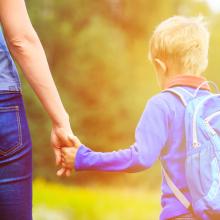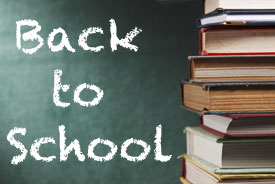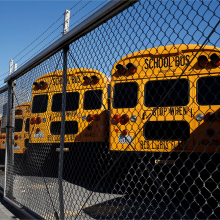back to school
This Tuesday marked back to school day for my two boys, who are entering fourth and sixth grade at an Episcopal school that welcomes students of all faiths. The annual rite — which for our family always seems to involve the Mission: Impossible-style task, led by my wife, of getting all the right books and school supplies in time — left me with mixed feelings, which I suspect many fellow parents share. On one hand, I am excited for all the new school year offers my kids: new teachers, new friends, a new season of athletics, and all the other extracurricular activities that bring my kids so much joy. On the other, I feel the weight of a mounting crisis in our nation’s education system, especially in public schools, where the pandemic revealed such deep and long-standing racial inequities.

Image via Nadezhda1906/Shutterstock
Robert Putnam’s new book, Our Kids: The Crisis in the American Dream, laments the decline in social capital (how we are connected to others and care for them) with its devastating impact on poor children today. Past generations of poor children often had more opportunities because they benefited from connections with churches, teachers, coaches, and other mentors who supported them. Putnam, a respected Harvard sociologist, documents how too many children are missing these caring adults in their lives today. He offers "purple solutions" to the growing "opportunity gap" and poverty that includes support by all for public schools.
Many churches witness to their concern for school children with a "Blessing of the Backpacks" service. Some churches invite the children in the congregation to bring their own backpacks for a blessing before a new school year begins. This is a way to acknowledge that school is a common yet very important part of our children’s lives. Other churches collect school supplies for children in need, assemble the donated supplies in backpacks, and bring them to church for a blessing in worship.
The tune of the following new hymn is the same Gaelic melody used for "Morning Has Broken," and it seems appropriate to sing a joyful "morning" tune as children, parents, and teachers start to get up earlier in the mornings to head off to school.
A life transition — like any effort to follow Jesus — is stressful: packing and unpacking, bidding farewells, refocusing from one set of commitments to a new future. It might be summarized in the early North African church leader’s interpretation of this Sunday’s Gospel reading from Luke 14:27: “Take up your stress and your tortures.” (Tertullian)
This September, my family’s transition from the hazy days of summer’s more casual pace back into the back-to-school rat race is tougher than usual. It not only involves our own children finding their way back onto their college campuses, but I am going too, to teach at Valparaiso University where I’ve been appointed to an endowed professorship which supports the study of Christian values in public and professional life.
Of necessity, most roads back-to-school are paved with lines of procedures, rules, and formalized rituals. The foundation of learning, however, is far less formalized or predictable — it’s more relational, like a disciple and master, protégé and mentor, choral director and chorister. Whether in musical arts, as in in Vy Higgensen’s Gospel for Teens program, or in biblical hermeneutics, the best learning happens in healthy relationships.
Imani walked down the hall with a paper cup in her hands.
She stopped and held up the cup to me. Inside of its paper walls were soil, water, and seeds — all those humble and elemental things that build a third-grader's scientific knowledge.
Imani was growing cabbage.
She was my student last year. She loved science and writing. I remember the look of wonder in her eyes when we studied weather. We learned about tornadoes. In my classroom, I had two 2-liter bottles connected by a tornado tube, a plastic piece that allows you to make a tornado by swirling the water around and around in one of the bottles. Imani held the bottles in her hands and marveled as her water formed into a giant, powerful funnel cloud.
"Wow," she whispered.
I love the sound of learning.
In Roald Dahl's classic children's book James and the Giant Peach, 7-year-old orphan James Henry Trotter escapes his two rotten, abusive aunts by crawling into a giant peach. The peach rolls, floats, and flies him to a new life of wonder and love.
I'm reading this book aloud for the first time, and my listeners are spellbound by the story, especially the part where the very small old man opens the bag filled with magical crocodile tongues that will help a barren, broken peach tree grow fruit as big as a house.
"There's more power and magic in those things in there than in all the rest of the world put together," says the man.
There is.
“What do you want to be when you grow-up?” is the pressure filled question that people begin asking as soon as they feel young people are old enough to answer.
From there it only gets worse. It’s a question I hated answering. Adults and media filled my mind with careers that would make me financially secure and, in their minds,  happy. So these careers filled my answers: doctor, lawyer, and pharmacist. I would be something important, and life after college would be financially easy.
happy. So these careers filled my answers: doctor, lawyer, and pharmacist. I would be something important, and life after college would be financially easy.
I babysat often through high school and remember a mom asking the dreaded questio
"Teachers are builders," said my friend. "You build safe learning environments for your students. You build safe spaces for your parents. You build knowledge and experience for yourselves. You build community with each other. You are builders."
I like her image.
This year I'm going to work on the 'building community with each other' part.
Editor's Note: Over the next two weeks, Sojourners is celebrating our teachers, parents, and mentors as children across the country head back to school. We'll offer a series of reflections on different aspects of education in our country.
My elementary school is a Title I school. About 97 percent of our students qualify for free and reduced lunch and Medicaid. Research shows us that many children raised in poverty struggle to learn to read. 
Common sense tells us that children who don't learn to read can't read to learn. They often reach a frustration level with school by the time they're in the third grade. According to the U.S. Department of Education, 70 percent of low-income fourth-grade students can't read at a basic level. I often wonder, "What can I do in my day-to-day work as a teacher to help?"





